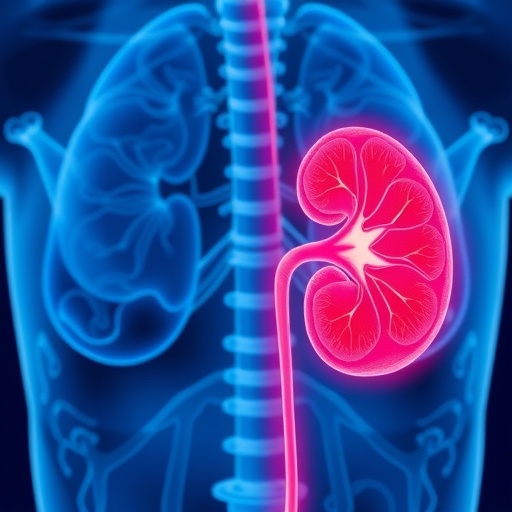In a groundbreaking advancement that could revolutionize the treatment paradigm for severe kidney inflammation, researchers from the University Hospital Bonn (UKB), the University of Bonn, and the University of Hamburg have unveiled compelling evidence supporting the efficacy of low-dose glucocorticoid therapy in crescentic glomerulonephritis (cGN). Published in the highly regarded journal Science Translational Medicine, this study meticulously elucidates how reduced and repeated steroid doses can sufficiently suppress kidney inflammation, mitigating the considerable adverse effects typically associated with high-dose steroid regimens.
Crescentic glomerulonephritis represents one of the most aggressive and perilous forms of kidney inflammation, characterized by rapid progression to end-stage renal disease within weeks if left untreated. The conventional therapeutic approach employs high doses of glucocorticoids, potent immunosuppressive agents that effectively curb inflammation but predispose patients to severe systemic side effects, including diabetes mellitus, osteoporosis, and heightened susceptibility to life-threatening infections. This delicate balance between efficacy and toxicity has driven an urgent need for therapeutic strategies that maintain effectiveness while minimizing collateral harm.
The investigative team, spearheaded by Professor Christian Kurts, Director of the Institute for Molecular Medicine and Experimental Immunology at UKB, embarked on a sophisticated exploration into the mechanistic underpinnings of steroid action within renal tissues. Utilizing cutting-edge methodologies such as single-cell and spatial transcriptomic sequencing, the research delineated a distinct subset of pro-inflammatory neutrophils—a type of innate immune cell—as pivotal mediators of kidney injury in cGN. Unlike circulating neutrophils, these localized populations arise within the inflamed renal microenvironment and exhibit prolonged activity, perpetuating tissue damage.
Crucially, the study’s experimental design incorporated murine models replicating the pathological features of human cGN, enabling precise interrogation of glucocorticoid dosing regimens. These models revealed that administering low, regularly spaced doses of glucocorticoids effectively inhibited the differentiation and persistence of pathogenic neutrophil subsets within the kidney, without the need for an initial high-dose bolus. This finding challenges the entrenched clinical dogma that aggressive steroid loading is indispensable in severe inflammatory states.
Detailed single-cell sequencing analyses provided unprecedented insights into the cellular trajectories and gene expression programs characterizing these nephritogenic neutrophils. By mapping their molecular signatures and spatial localization, the researchers identified key differentiation pathways and inflammatory mediators that are selectively attenuated by low-dose glucocorticoid exposure. Such precise mechanistic understanding opens avenues for more targeted pharmacologic interventions, aiming to preserve beneficial immune functions while selectively dampening deleterious pathological activity.
Parallel investigations involving kidney biopsies from patients undergoing low-dose glucocorticoid therapy corroborated the preclinical findings, demonstrating a marked reduction in the abundance of pro-inflammatory neutrophils. This translational evidence not only validates the animal model results but also emphasizes the therapeutic potential and clinical relevance of refined steroid dosing protocols. By attenuating immune cell-driven renal damage with fewer medications and reduced toxicity, patient outcomes may significantly improve.
Professor Kurts underscores the transformative impact of these findings, emphasizing that “clinicians no longer need to rely on indiscriminately high doses of steroids to suppress damaging immune cells; rather, strategic, low-dose regimens may suffice to achieve the desired anti-inflammatory effects.” This paradigm shift could not only alleviate the long-term burden of steroid-associated complications but also enhance patient compliance and quality of life.
Dr. Junping Yin, the study’s first author, elaborates on the technological advancements that facilitated these discoveries, stating that “the application of single-cell sequencing techniques has enabled us to ‘see’ and track pathogenic neutrophils in their native inflammatory milieu, providing critical insights into their origin, function, and response to treatment.” Such high-resolution analyses are instrumental in unraveling the complex cellular interplay governing immune-mediated kidney injury.
Future clinical trials inspired by this research initiative will be essential to validate safety, dosage parameters, and therapeutic efficacy in diverse patient populations afflicted by cGN. Should these studies confirm the preclinical success, they could catalyze a paradigm shift in managing not only crescentic glomerulonephritis but also a broad spectrum of autoimmune and inflammatory diseases currently reliant on high-dose steroid therapy.
The implications of adopting low-dose glucocorticoid regimens are far-reaching. By selectively targeting the local differentiation of pathogenic neutrophils, clinicians may substantially reduce systemic immunosuppression, thereby diminishing the risk of debilitating side effects and secondary morbidities. This precision medicine approach aligns with contemporary efforts to tailor treatments based on detailed molecular and cellular understanding of disease pathogenesis.
Moreover, this strategy exemplifies how integrating advanced immunological techniques with translational animal models can accelerate the development of safer, more effective therapies. The study’s sophisticated use of spatial gene sequencing offers a blueprint for dissecting tissue-resident immune populations, informing drug development across multiple disciplines.
Ultimately, the promising findings from Professor Kurts’ team illuminate a path towards safer, more efficient, and patient-centered management of crescentic glomerulonephritis. By refining glucocorticoid therapy to lower doses, repeated strategically over time, the medical community moves closer to balancing potent anti-inflammatory action with preservation of systemic health — a critical advancement in nephrology and immunotherapy.
Subject of Research:
Article Title:
News Publication Date:
Web References:
References:
Image Credits: University Hospital Bonn / lab Prof. Christian Kurts
Keywords: crescentic glomerulonephritis, cGN, low-dose glucocorticoids, steroids, kidney inflammation, neutrophils, single-cell sequencing, spatial gene sequencing, immunosuppression, kidney biopsy, autoimmune disease, translational medicine
Tags: advancements in kidney inflammation therapycrescentic glomerulonephritis treatmentend-stage renal disease preventionimmunosuppressive agents in nephrologykidney inflammation managementlow-dose glucocorticoid therapyminimizing steroid toxicityrenal tissue steroid actionScience Translational Medicine publicationsteroid side effects in patientstherapeutic strategies for kidney diseaseUniversity Hospital Bonn research





